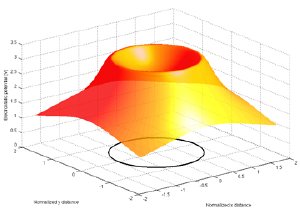A chemist at the University of Wisconsin-Milwaukee (UWM) has developed a kind of invisible fence for trapping and controlling particles as small as a single virus or large protein.
 This 3D graphic shows the "corral," or trapping area, which resembles a crater, surrounded by the slopes that represent the voltage of the charged surface.
This 3D graphic shows the "corral," or trapping area, which resembles a crater, surrounded by the slopes that represent the voltage of the charged surface.
The technique, developed by Assistant Professor Jörg Woehl, takes advantage of the strong electrostatic field that exists in close proximity to tiny particles that carry an electrical charge.
So far, Woehl and doctoral student Christine Carlson have confined particles of about 20 nanometers-the size of a virus-using the trap. But it is expected to work equally well for smaller molecules, giving it great potential as a tool in nanotechnology and biotechnology.
"Our ultimate objective is to go down to a single molecule," he says. "We are well on our way."
Unlike other methods currently available, Woehl's technique is capable of trapping much smaller particles, and it can capture many particles at a time and hold them without the need for monitoring the particles' position.
How it works
The trap is formed by a hole in a thin metal film deposited on a substrate. A solution containing the particle of interest is added to the surface. When the particle travels within the hole, or the trapping region, a voltage is applied. The particle remains confined there because all other areas of the surface are charged.
"The trapping field is created when the metal film is charged," says Woehl. "Remove the voltage, and the particle is released."
Depending on the charge of the particle, it will either remain trapped in the center of the corral, wiggling around due to collisions with molecules in the surrounding liquid, or it will move along the circular outline of the trap. For example, applying a negative voltage to the trap causes negatively charged molecules that are captured in the hole to be repelled from the rim area (since they carry the same charge).
Similarly, the application of a positive charge to the metal film causes a negatively charged particle to be trapped along the perimeter of the hole. But Woehl and Carlson were surprised to also find that these particles travel continuously around the rim while trapped. This is a behavior they have not yet explained.
The two have created a three-dimensional picture of the trap that resembles a crater at the top of a hill. They can control the depth of the "crater," which corresponds to the uncharged region, by increasing the voltage to the metal surface.
Woehl and Carlson are presenting a poster on their research at the American Chemical Society's national meeting this month.
Applications
Woehl's trapping method could lead to new ways of interacting with the nanoworld such as the bottom-up assembly of complex molecular nanostructures or DNA manipulation, says Woehl.
Because it can capture several particles at once, it could be used as a micro-scale test tube to monitor chemical reactions happening among particles, he says. This kind of tool could also contribute to better biomedical testing technologies that would require only the slightest amount of material for a detailed analysis.
Trapping single molecules such as RNA or proteins over an extended period of time, for example, could give scientists a better understanding of the factors that influence how they change shape - knowledge which could have important biomedical implications.